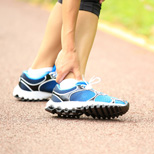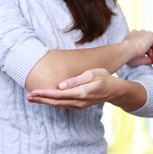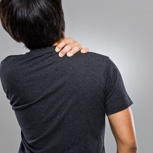INJURY BY BODY PART
ANKLE
Achilles Tendon Rupture
Background & Etiology (Cause)
The ankle region contains two joints, the ankle joint and the subtalar joint. These joints must be strong because they support the weight of the entire body while enabling us to run, walk, and jump with precision and flexibility. Tendons are connective tissues that attach muscle to bone. They are strong, fibrous structures that are responsible for transferring the forces generated by the muscle to the bone, thus producing movement at the joint. When a tendon becomes irritated or inflamed it becomes painful, causing tendonitis. The tendons in the ankle region are subject to significant stress, and can rupture under extreme pressure.
Tendon Rupture
When a tendon ruptures it can be extremely painful and cause a disability of the foot that then subsequently causes damage to the ankle joints. The tendons in the ankle include: the peroneals (peroneus brevis, peroneus longus,) anterior tibialis, posterior tibialis, and Achilles tendon. Any of these structures can become ruptured, which is a serious condition that will typically require surgery to fix.
Achilles Tendon
The Achilles tendon is the largest tendon in the body. It is formed where the gastrocnemius muscle and soleus muscle of the calf join together. It runs from the calf muscles to the heel bone. The Achilles tendon plays a significant role in enabling us to walk, run, stand on one’s toes and jump. Because the calf muscles are used for activities that produce great stress on the Achilles tendon, it is one of the most frequently ruptured tendons in the body. Pain from an Achilles tendon rupture commonly occurs at the back of the foot in the vicinity of the heel.
The Achilles tendon is one of the most vulnerable tendons in the body because while tendons are strong, they can only be stretched so far before they tear or rupture and the Achilles is typically subject to a significant amount of stress. The Achilles tendon attaches the gastrocnemius (calf) muscles and the soleus muscles in the lower leg to the heel of the foot. The movement of these muscles is crucial for proper function of the foot, ankle, and even the knee. When the Achilles tendon is injured it can cause a serious dysfunction of these structures.
Causes
Common causes of an Achilles tendon rupture include
- The progression of or the final result of longstanding Achilles tendonitis or an overuse injury.
- An injury to the ankle or a direct blow to the Achilles tendon.
- Laceration of the tendon
- Weakness of the gastrocnemius or soleus muscles in people with existing Achilles tendonitis places increased stress on the tendon.
- Steroid use has been linked to tendon weakness
- Certain systemic diseases have been associated with tendon weakness.
- A sudden deceleration or stopping motions that cause an acute traumatic injury of the ankle.
- Injection of steroids to the involved tendon or the excessive use of steroids has been known to weaken tendons and make them susceptible to rupture.
- Contraction of the calf muscles while the foot is dorsiflexed (pointed toward the head) and the lower leg is moving forward.
Symptoms of Achilles Tendon Ruptures
- Ankle pain and swelling or feeling like the ankle has “given out” after falling or stumbling.
- A loud audible pop when the ankle is injured.
- Patients may have a history of prior ankle pain or Achilles tendonitis, and may be active in sports.
- Swelling, tenderness and possible discoloration or ecchymosis in the Achilles tendon region.
- Indentation above the injured tendon where the torn tendon may be present.
- Difficulty moving around or walking.
- ndividual has difficulty or is unable to move their ankle with full range of motion.
- MRI can confirm disruption or tear in the tendon.
- Inability to lift the toes.
Treatment of Achilles Tendon Rupture
Early diagnosis and treatment is the key to a successful outcome for an Achilles tendon rupture. If diagnosis or treatment is delayed the integrity of the healing tissue can be compromised as a result of scarring and decreased blood flow. Surgical repair followed by structured and aggressive physical therapy is the treatment of choice for complete ruptures. In the case of a small partial tendon tear conservative treatment without surgery is an option.
Partial (small) Achilles Tendon Tear
- Immobilization of the ankle for 3-6 weeks to rest and promote healing. Individual will be placed in an immobilizer or brace and will move around with crutches to keep weight off of the leg.
- Physical Therapy: following the period of immobilization your physician will decide when you are ready for physical therapy. Treatment will emphasize gradual weaning off the immobilizing device, increasing weight bearing, restoration of ankle range of motion and strengthening of the associated muscles. It is important that the physician and therapist communicate during the early stages and progress your recovery program based on the principles of healing so as not to compromise the injured tendon.
- Patient will be progressed to more functional activities as normal ankle range of motion and strength is restored.
Treatment of Complete Achilles Tendon Ruptures
- Immediate surgical repair of the tendon is indicated in complete tears. Delaying surgery can lead to shortening of the tendon, formation of scar tissue and decreased blood flow, which can lead to a poor outcome.
- Following surgery your ankle will be put in an immobilizing device and you will be instructed to use crutches to limit weight bearing and protect the joint.
- Over the next 2-4 weeks weight bearing will be increased and physical therapy will be initiated.
- The surgeon will determine the physical therapy timeline and program.
- Physical Therapy: treatment will emphasize gradual weaning off the immobilizing device, increased weight bearing, restoration of ankle range of motion and strengthening of the lower leg muscles. It is important that the physician and therapist communicate during the early stages and progress your program based on the principles of healing so as not to compromise the Achilles tendon.
- Patient will be progressed to more functional activities as normal ankle range of motion and strength is restored.
Physical therapy for a tendon rupture must remain conservative at the onset in order to protect the repair. Emphasis will be on rest, tendon protection, reducing the inflammation and increasing the blood circulation for healing. Following the surgeon’s timeline and protocol, a program of progressive weight bearing, stretching and strengthening will be initiated.
Physical Therapy Interventions
Common Physical Therapy interventions in the treatment of Achilles Tendon Rupture include:
- Manual Therapeutic Technique (MTT): hands on care including soft tissue massage, stretching and joint mobilization of the ankle by a physical therapist to improve joint mobility and range of motion of the ankle. Use of mobilization techniques also helps to modulate pain.
- Therapeutic Exercises (TE) including stretching and strengthening exercises to regain range of motion and strengthen the gastrocnemius and soleus muscles of the ankle and lower extremity.
- Neuromuscular Reeducation (NMR) to restore stability, retrain the lower extremity and improve movement techniques and mechanics (for example, running, kneeling, squatting and jumping) of the involved lower extremity to reduce stress on the tendons in daily activities. Taping, strapping or bracing may be indicated to rest tendon and promote healing.
- Modalities including the use of ultrasound, electrical stimulation, ice, cold, laser and others to decrease pain and inflammation of the involved tendon and bursa.
Prognosis
If repair and treatment are initiated immediately, individuals with a rupture or tear the Achilles tendon generally do well. Delay can result in the formation of scar tissue and retraction of the tendons. Other factors that can affect recovery are:
- Age: Older individuals are generally weaker and take longer to heal affecting the functional outcome.
- Strength: Individuals who are strong and in good condition prior to the injury generally do better following surgical repair.
- Tissue: Tissue quality prior to the surgical repair will effect healing and recovery following surgery. Poor circulation and presence of scar tissue will interfere with the healing process.
The healing time for a tendon repair will take up to 8-12 weeks but restoration of function and ability to accept full activity, load and stress can take up to one year.
- Kendall Park
- Edison
- Princeton
- Old Bridge
- Monroe





















